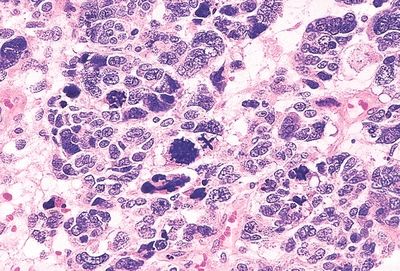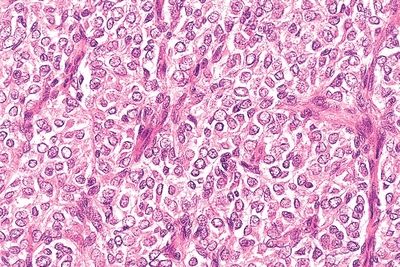QUESTION 43.2
A. Diffuse blastemal
B. Nested blastemal
C. Tubular
D. Mixed
E. All of the above
3. A Wilms tumor with the morphologic changes illustrated in this picture will most likely have which of the following genetic alterations?

QUESTION 43.3
A. Inactivation of the INI1 gene
B. P53 mutations
C. Translocation t(10;17)
D. Translocation t(X;18)
E. Translocation t(12;15)
4. The renal tumor known as mesoblastic nephroma is characterized by:
A. Development in fetal life
B. Highly aggressive behavior
C. Mesenchymal and epithelial elements
D. Multiple cysts lined by tubular epithelium
E. Small round cell morphology
5. A nephrectomy specimen from a 2-year-old boy shows a well-circumscribed homogeneous tumor in the medullary region. Its histologic features are shown in this medium-power picture. Mitoses are frequent. Only vimentin immunoreactivity is demonstrated in tumor cells. The child has metastases in the skull and the brain. Which of the following is the most likely diagnosis?

QUESTION 43.5
A. Clear cell sarcoma
B. Medullary fibroma
C. Mesoblastic nephroma
D. Multicystic nephroma
E. Wilms tumor
6. This picture shows the histologic appearance of a renal tumor from a 1-year-old boy. Tumor cells express vimentin, keratin, and EMA and are negative for INI1. Which of the following is the diagnosis?

QUESTION 43.6
Stay updated, free articles. Join our Telegram channel

Full access? Get Clinical Tree


